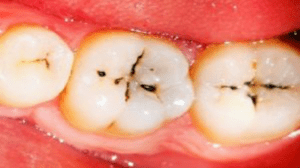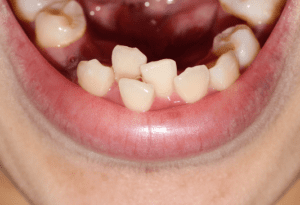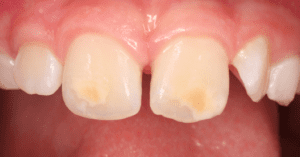Disclosure:: This post is sponsored by Lafayette Pediatric Dentistry and authored by Dr. Anita Gouri.
The 5 Most Common Causes of Cavities
I know I know, you’re probably over hearing me talk about sugary snacks, gummies, and juice in your child’s diet, but actually this time I’m going to discuss why children who have very healthy diets can still get cavities! Here are the five most common causes of cavities that I see in my practice:
“Groovy” Teeth
Deep grooves and pits in the teeth are just a normal part of dental anatomy, and are a great place for trapping food and sugars for bacteria to feast on. The most common type of cavity is a “pit and fissure” cavity. These form at the base of a deep groove or pit in a molar or premolar (back teeth). We see these frequently, even in the cleanest of mouths, because the toothbrush bristles can only penetrate the depths of the crevices so far.
of cavity is a “pit and fissure” cavity. These form at the base of a deep groove or pit in a molar or premolar (back teeth). We see these frequently, even in the cleanest of mouths, because the toothbrush bristles can only penetrate the depths of the crevices so far.
So what can we do to prevent these types of cavities?
Make sure your child gets dental sealants on their molars. These are protective coatings that act as a “caulking” to seal over all of these pits and grooves to help prevent cavities from forming inside. Along with good oral hygiene and minimal consumption of sugary snacks and beverages, sealants can help prevent up to 80% of cavities from forming in the back teeth.
Orthodontic Crowding
When the teeth have no room to align themselves properly due to lack of space in the  jaws, they tend to come in overlapped and rotated, making oral hygiene around these teeth and gums very difficult. When there is no space between the baby teeth, the contacts the teeth make with each other are very “tight” and often difficult to floss between, and we see a lot of cavities forming between the teeth. Any area in the mouth that is difficult to clean is a haven for cavity-causing bacteria. Additionally, we anticipate that the lack of space early on will lead to orthodontic crowding later in life.
jaws, they tend to come in overlapped and rotated, making oral hygiene around these teeth and gums very difficult. When there is no space between the baby teeth, the contacts the teeth make with each other are very “tight” and often difficult to floss between, and we see a lot of cavities forming between the teeth. Any area in the mouth that is difficult to clean is a haven for cavity-causing bacteria. Additionally, we anticipate that the lack of space early on will lead to orthodontic crowding later in life.
So what can be done to prevent orthodontic crowding?
When the jaws are small, early orthodontic intervention can be very beneficial. Both of my daughters had narrow palates and greatly benefitted from a process called palatal expansion, which widens the upper jaw. Once this very simple and painless process was complete, my children’s teeth came in completely straight and their jaws were nice and rounded, instead of V-shaped and narrow. There are other minor orthodontic procedures that can be done early on to prevent crowding, which is why we always recommend an orthodontic consultation early in life, prior to losing all baby teeth, to intervene at the correct time.
Until the time comes when a child is old enough for orthodontic intervention, meticulous flossing, brushing, and limiting of sugary snacks are the best way to prevent cavities forming between the teeth.
Dry Mouth
A dry mouth is always more susceptible to cavity formation, because the buffering and  protective capacity of the saliva is missing or reduced. Saliva has protective minerals, digestive enzymes, and a hydrating capacity that helps clear the damage done by harmful bacteria. Unfortunately, many medications, particularly those for asthma and allergy, can cause dry mouth by inhibiting secretions in the body. Since these medications are necessary, the best defense against dry mouth in this case would be to increase frequency of brushing and decrease sugary snacks and beverages that feed oral bacteria. There are also some salivary stimulants that may aid in severe cases.
protective capacity of the saliva is missing or reduced. Saliva has protective minerals, digestive enzymes, and a hydrating capacity that helps clear the damage done by harmful bacteria. Unfortunately, many medications, particularly those for asthma and allergy, can cause dry mouth by inhibiting secretions in the body. Since these medications are necessary, the best defense against dry mouth in this case would be to increase frequency of brushing and decrease sugary snacks and beverages that feed oral bacteria. There are also some salivary stimulants that may aid in severe cases.
Many people simply breathe mostly through their mouths and not their noses. Chronic mouth breathing often leads to chronic dry mouth, especially at night, when salivary flow naturally decreases. For mouth breathers, there are corrective steps that can and should be taken, as air exchange should occur primarily through the nose at least 95% of the day and night for optimal health. Chronic mouth breathing is usually caused by an underlying issue, such as obstructive nasal anatomy, enlarged tonsils, a tongue tie, small jaws, and/or many other conditions. At Lafayette Pediatric Dentistry, we are trained to help identify causes of mouth breathing and get your child on the corrective path to nasal breathing.
Hereditary/congenital conditions affecting enamel quality
Sometimes, you are just born with a condition called enamel hypoplasia. This can be  caused by a disturbance, illness, and/or medication during tooth calcification as an infant or in utero, but many times the cause is unknown. In this case, tooth enamel is defective, making the tooth more susceptible to cavities. Genetic pre-disposition to weaker enamel can also be a contributing factor to cavities—I see many families where siblings with near identical hygiene and diets have very different susceptibilities to tooth decay.
caused by a disturbance, illness, and/or medication during tooth calcification as an infant or in utero, but many times the cause is unknown. In this case, tooth enamel is defective, making the tooth more susceptible to cavities. Genetic pre-disposition to weaker enamel can also be a contributing factor to cavities—I see many families where siblings with near identical hygiene and diets have very different susceptibilities to tooth decay.
Meticulous dental care, regular visits to the dentist, low sugar diets, and preventive measures like fluoride treatments and sealants are the only way to aid in cavity prevention on teeth with weaker enamel. In many cases, new advances in fluoride treatments such as silver diamine fluoride and prescription fluoride toothpastes have been very effective in keeping the tooth healthy into adulthood.
The #1 cause of cavities? You guessed it: Not taking care of your teeth.
Have you noticed a common theme at the end of every bullet point? It has to be said: the simplest explanations for cavities are the most common ones—poor oral hygiene and frequent sugar intake. Dental plaque is a biofilm that forms on the tooth when oral bacteria, feeding on food debris remaining on the teeth, form sticky micro-colonies on and in between enamel surfaces. This biofilm has to be brushed and flossed away regularly to prevent these micro-colonies from causing decay, which results from acid they release while metabolizing sugars. Are you brushing and flossing your child’s teeth at least twice every day? Then let’s take a look at sugary snack intake. If the frequency with which your child snacks or sips on sugary items is moderate to high, then the acidic balance of the oral cavity tips in favor of the bacteria. Frequent sugar intake throughout the day does not allow the mouth time to recover from these acidic bacterial “feasts.” Recovery occurs from brushing/flossing and the buffering capacity of saliva, which restores the mouth to a less acidic pH between eating and drinking.
We currently live in a “grab-n-go” society, where our fuel is processed, sugary or starchy snacks like granola bars, gummies, goldfish, and sports drinks. Fuel is necessary of course, but these items are unfortunately loaded with sugar. Whenever possible we always suggest consuming items like whole fruit, cheese, whole grains, and water instead! This way, along with proper oral hygiene, we are doing our part to keep our teeth healthy when there are so many other cavity risk factors that may be beyond our control.
Make sure your child visits us to determine if they have any of these pre-disposing risk factors by having us do a cavity-risk assessment. We also make it a point to review meticulous oral hygiene and dietary habits with all of our patients and parents at each 6 month check-up, to promote healthy smiles for life!
Call us anytime if you’d like more information!
337-981-9242 x1



















